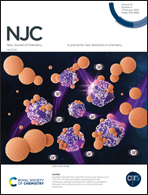A 3D carbon black disposable electrochemical sensor modified with reduced graphene oxide used for the sensitive determination of levofloxacin†
Abstract
In this work, a simple method for the fabrication of an electrochemical sensor using a conductive carbon black and polylactic acid-based filament (3D-CB/PLA) printed with a 3D-pen is presented. The sensor was later modified with reduced graphene oxide (rGO), and for the first time was used for monitoring levofloxacin (LEV) in pharmaceutical formulations, synthetic urine, and tap water samples by differential pulse voltammetry (DPV). The characterization by scanning electron microscopy (SEM), electrochemical impedance spectroscopy (EIS), and cyclic voltammetry (CV) demonstrated that the electroanalytical performance of the modified sensor compared to the unmodified electrode was increased 3.7-fold, moreover an anticipation of the LEV oxidation potential by 120 mV was observed, which characterizes the electrocatalytic effect promoted by the rGO nanosheets attached on the 3D-printed carbon black surface. Additionally, the proposed method presented a linear working range from 10 to 50 μmol L−1 and a detection limit of 2.17 μmol L−1. Moreover, excellent precision (RSD < 6.5%) and accuracy with recovery for spiked samples ranging from 95.4 to 104.8% were obtained. The sensor was also selective against the main antibiotics reported in the literature. Therefore, it can be claimed that 3D printed devices are promising for implementation in routine methods.



 Please wait while we load your content...
Please wait while we load your content...